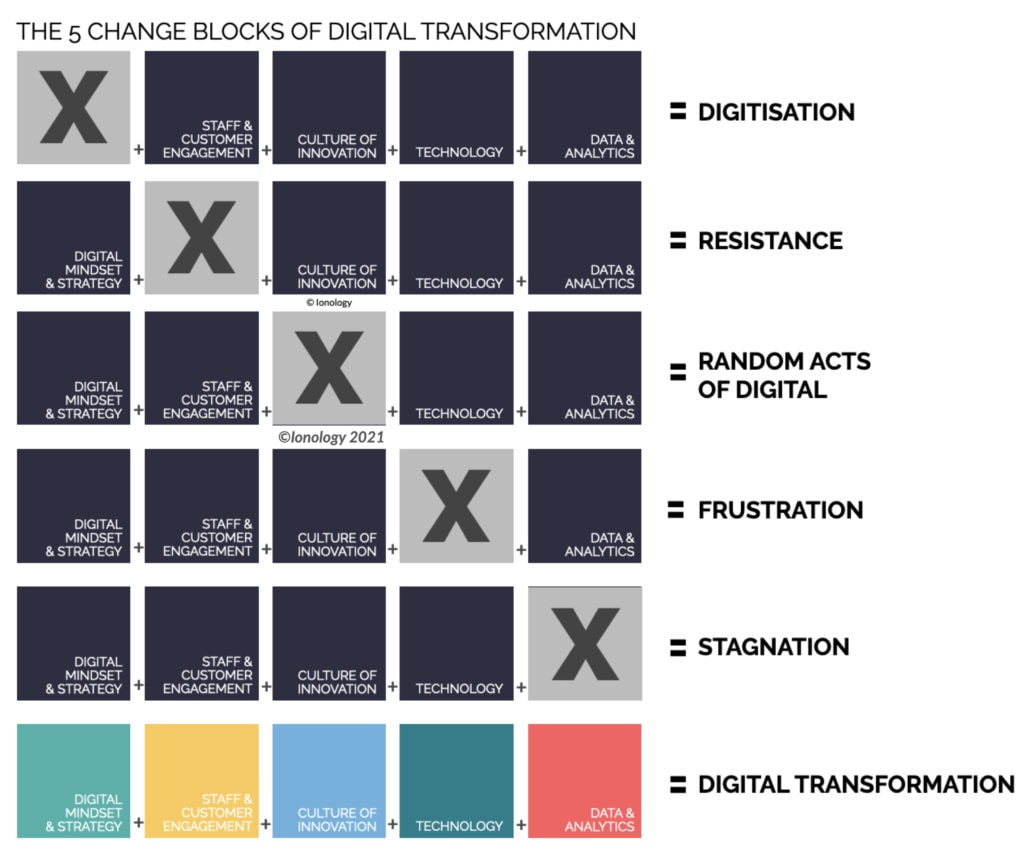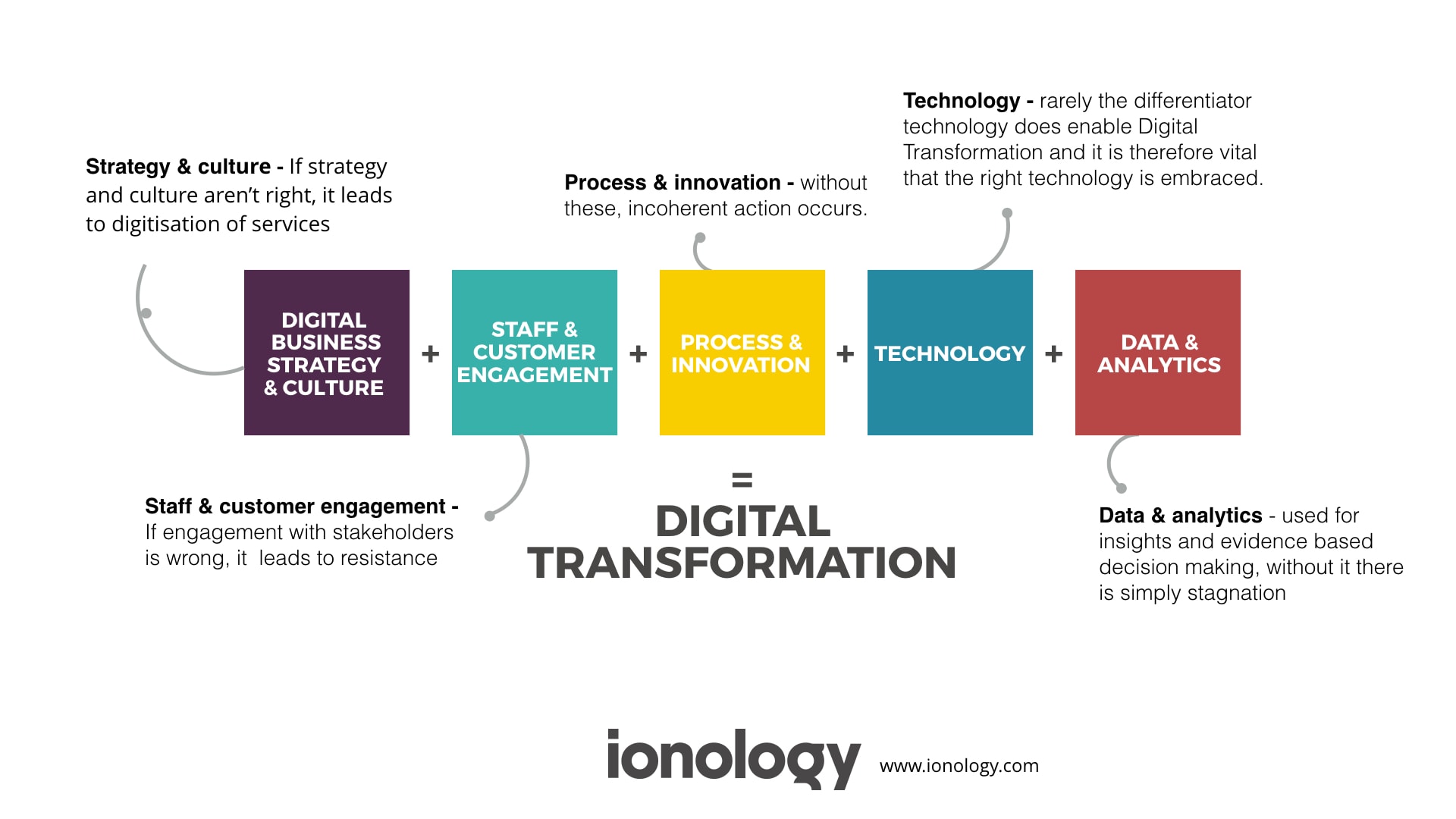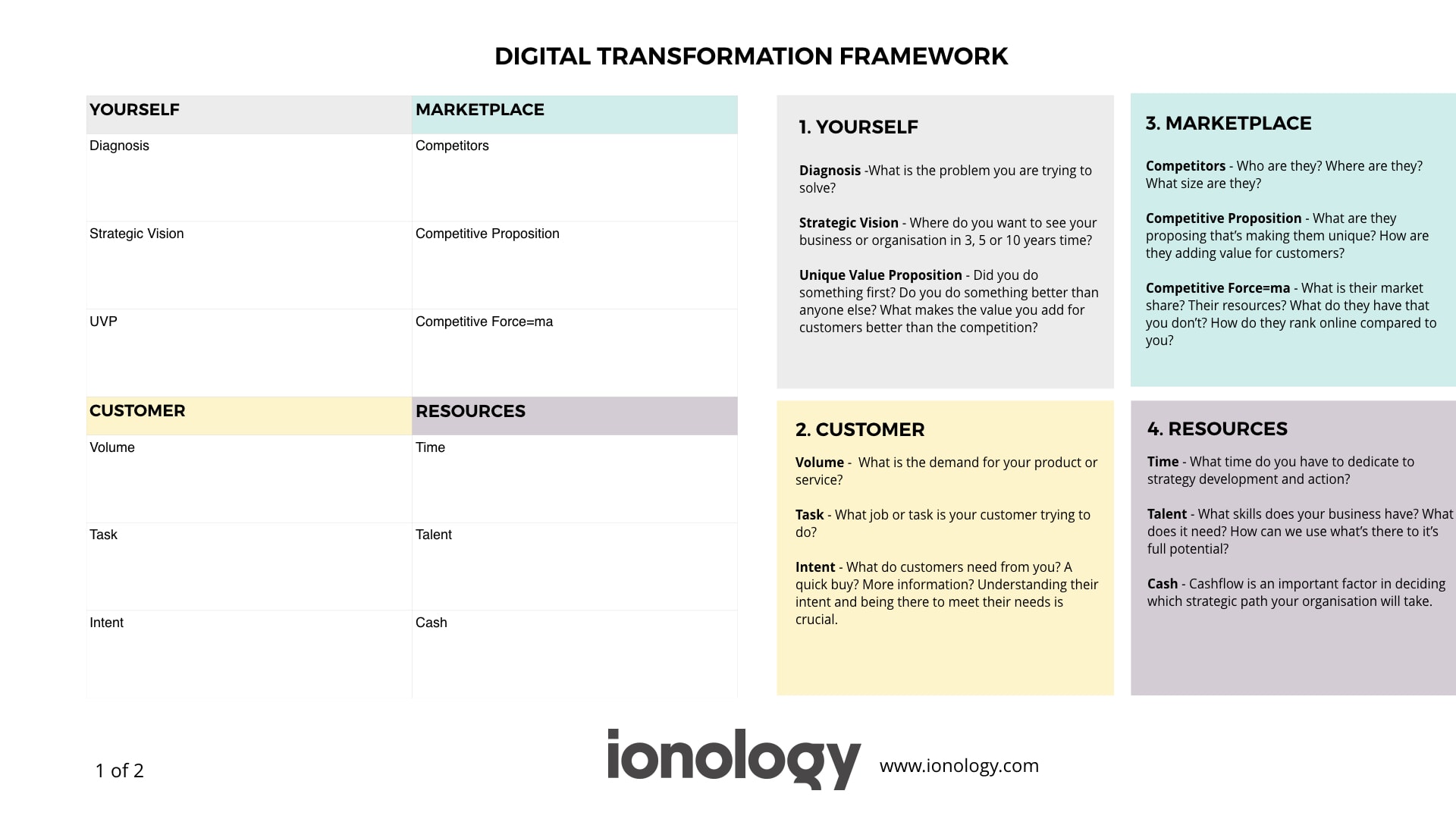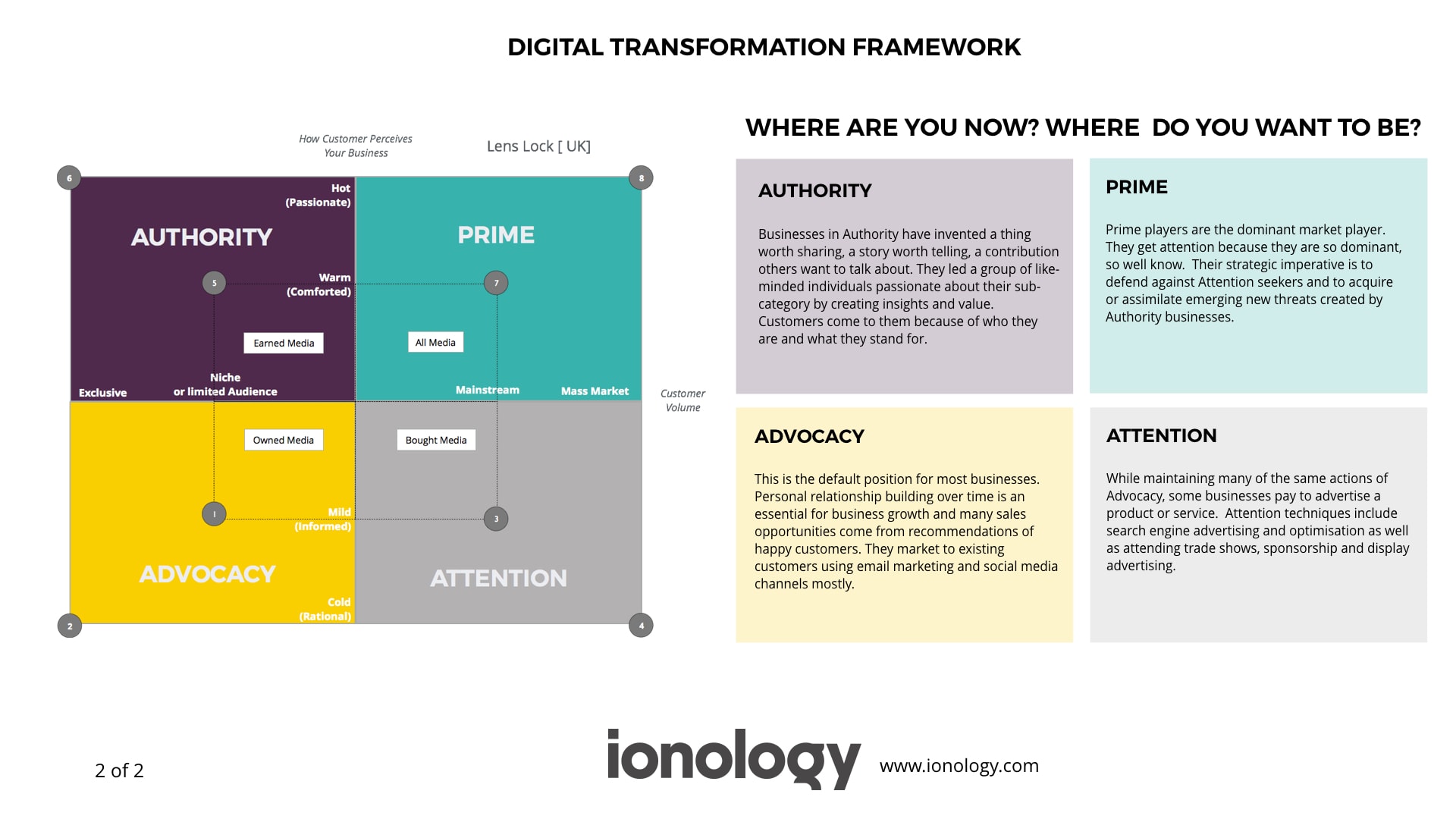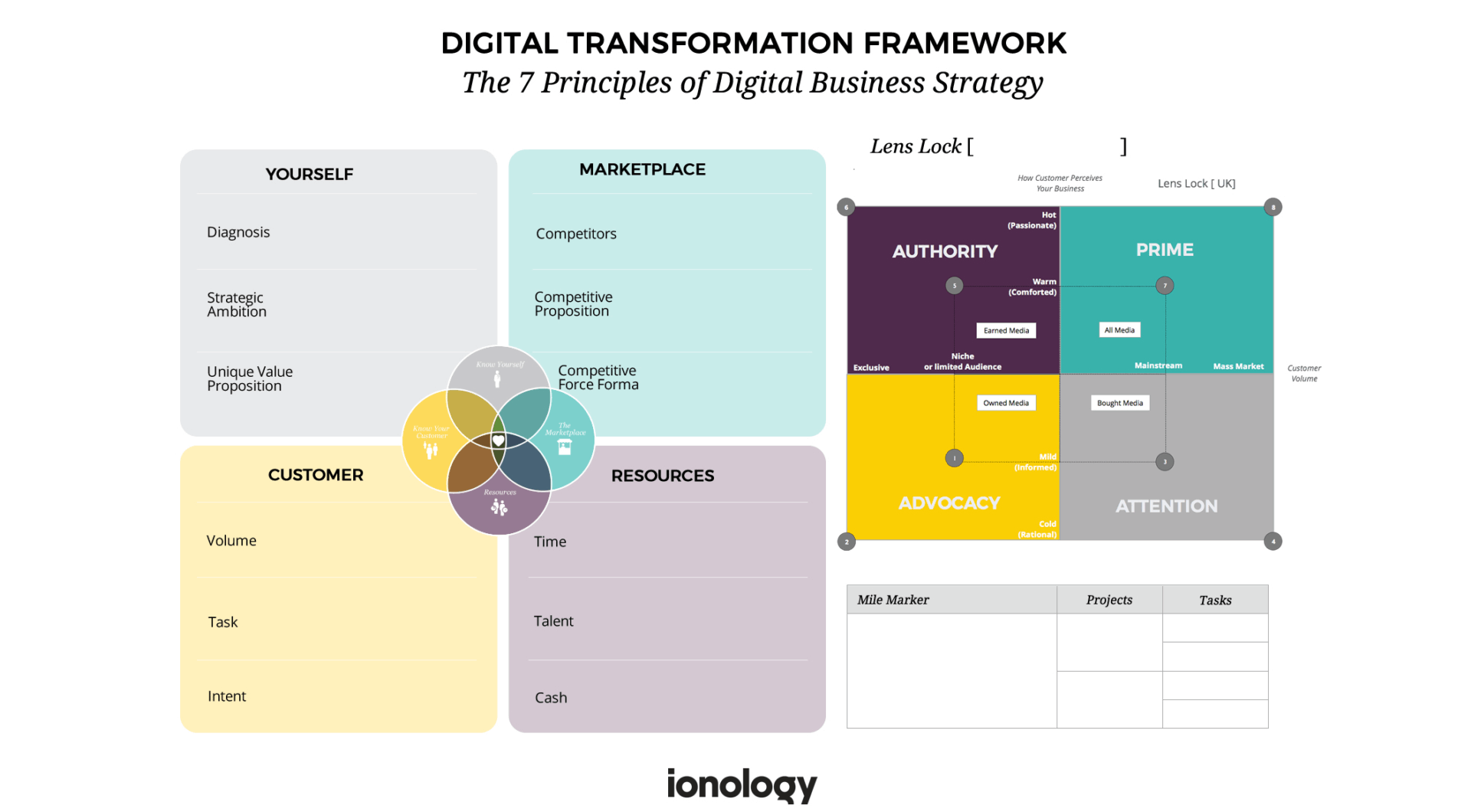Use these quick links below to find our more about our Digital Transformation Framework:
What is a Digital Transformation Framework?
A digital transformation framework is a tool, often used by consultants and organisational leaders, to analyse a business in order to assist it to reposition it in the digital economy.
Modern digital transformation frameworks are data powered and differ from older management consulting frameworks which tend to be subjective in nature.
The purpose for using a digital transformation framework is to create a repeatable method or process when planning and guiding a digital transformation.
While there are many interpretations of the term ‘digital transformation’, in the context of business and consulting, it is recognised that digital transformation is the act of repositioning an organisation in the digital economy, leveraging technology, in order to maximise its opportunity so it may better service current and new, customers/citizens/donors/voters….
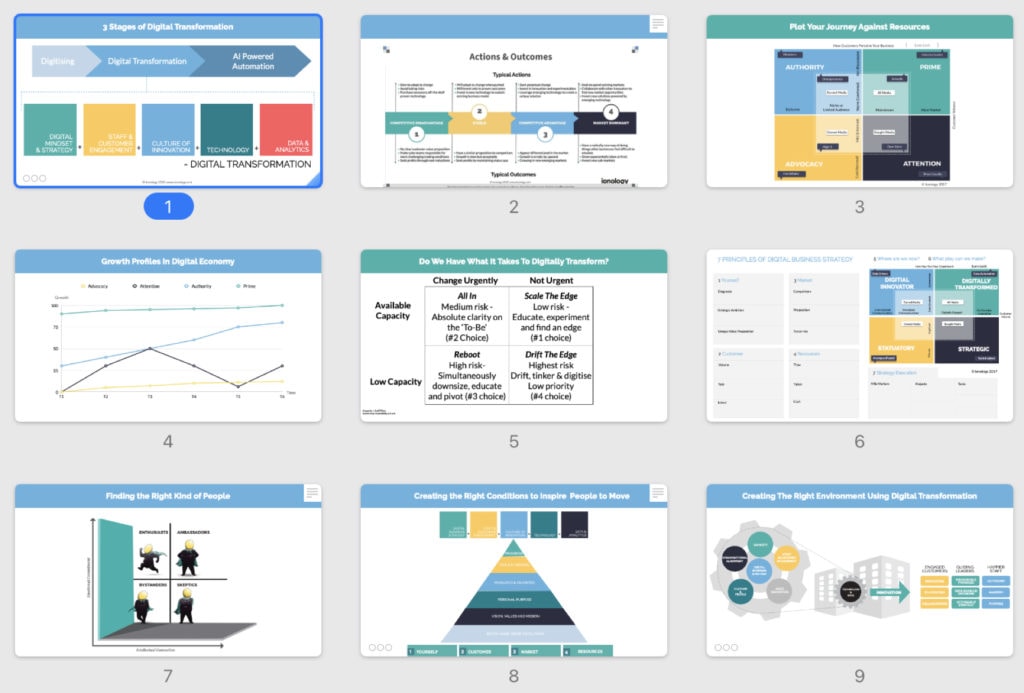
Why Use a Digital Transformation Framework Platform?
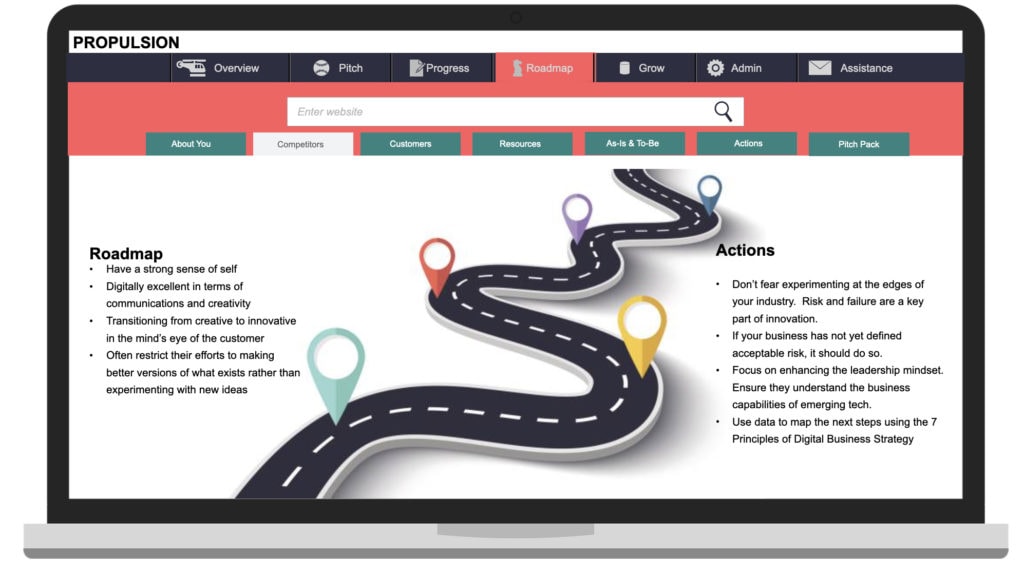
A digital transformation framework is used to create a repeatable method of diagnosis, strategic planning and implementation, when it comes to repositioning a business in the digital economy.
The framework ensures the Digital Transformation professional has control over the levers when it comes to achieving a transformed state of a business and the focus extends beyond technology.
The framework keeps focus on the things that matter; customer value, market position and competitors, rather than getting distracted by the shiny lights of technology.
Technology can act as an important inspiration. In our experience however, many digital transformations fail even when the technologists deliver. Technology experts usually deliver exactly what has been asked for. It’s what was asked for, that’s the problem.
When it comes to the transformation of a business, technology is the enabler, not the destination.
So what is your business transforming into? Can it be articulated? If not, you likely need frameworks and models that can help guide the thinking, planning, communications, innovation and technology choices .
Digital Transformation Framework for Customer Insights
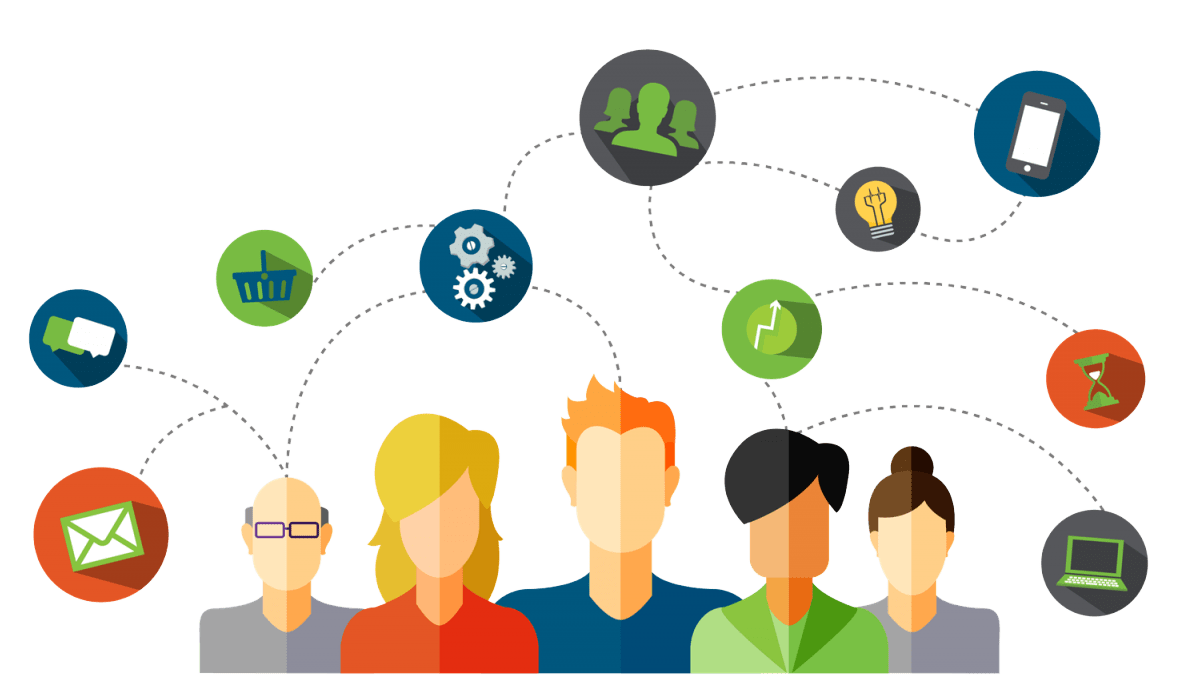
Let’s face it, the big consulting firms get it easy when it comes to winning consulting business in the digital transformation space. Their brand carries them through most doors and half way up the procurement staircase. Few question their credentials. However, take a closer look at most of their ‘digital transformation frameworks’ and you’ll find they are exactly the same as the old management consulting tools they’ve used for the past 30 years. Old, subjective, analogue and not designed for the digital age.
Chief Digital Officers as well as smaller consultancy firms have to show much greater insight before business leaders will take them seriously. They need to come up with fresh insights in context with the customer’s business.
But how do you get fresh insights before you start consulting?
Data + Frameworks – that’s how!
Finding fresh insights is easy when we use digital transformation pitching frameworks and platforms.
You can tell a lot about a business by its digital footprint. Over time a business publishes its value proposition, those that influence their industry produce a very different data footprint to those that passively participate.
Pitch Fresh Customer Insights

Measuring the digital footprint of a business is very different from looking at its digital marketing. A business can have great digital marketing but a poor digital footprint.
Innovators in all industry and government institutions show similar data characteristics of success over time. The digital innovators outpace those that are just ‘doing digital’. These characteristics can be compared against the industry peers and a market position and calculated. This kind of data provides the ‘As-Is’ state.
This comparison of how a business or business unit is performing against those inside and outside their industry creates stimulating insights and conversations.
Using modern digital transformation consulting platforms and frameworks can be a super-accelerated way of demonstrating competence and maturity in digital transformation. From the get-go you’re providing insights even for customers you know little about.
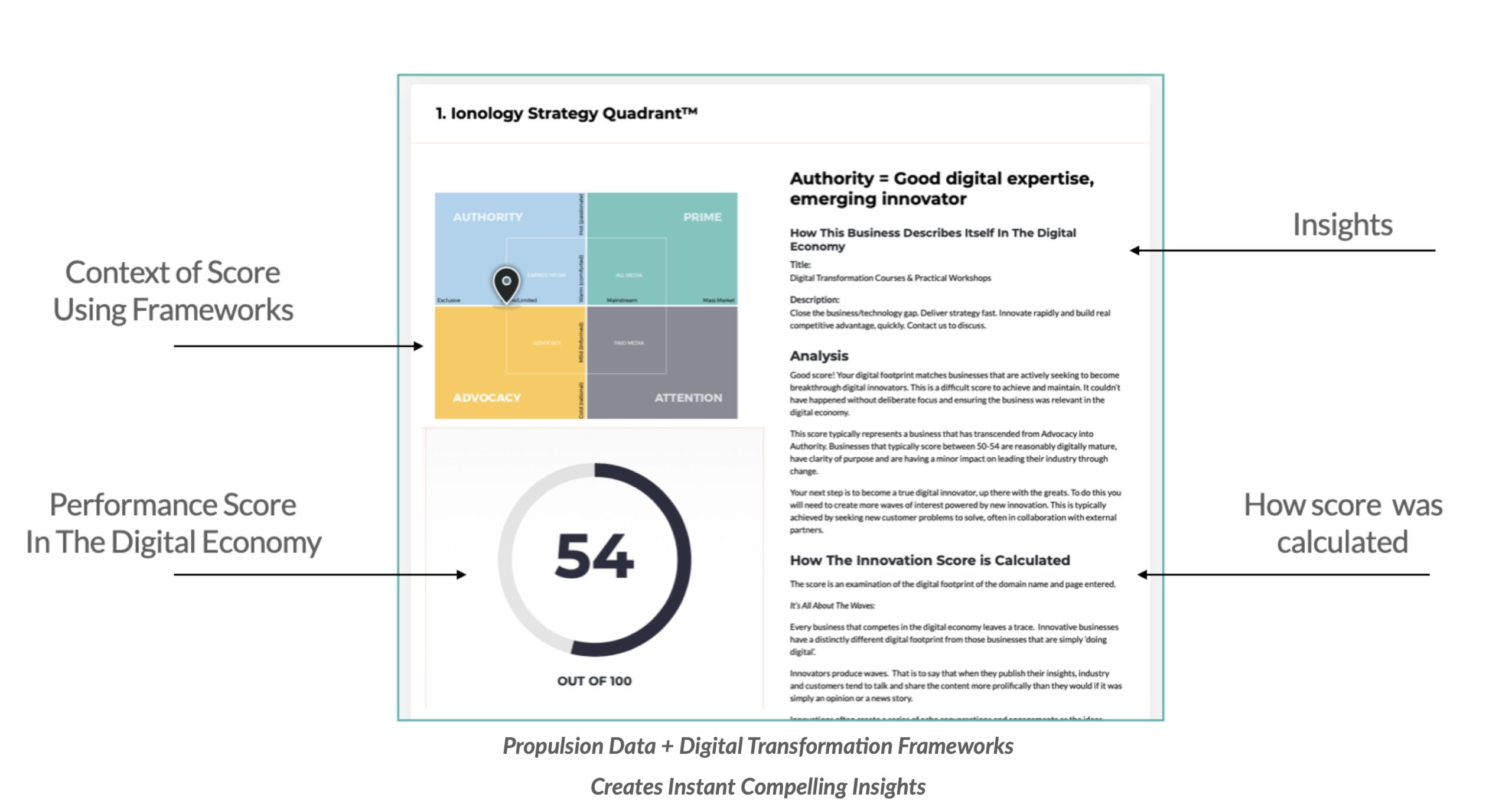
At Ionology we’ve invented Propulsion. It’s a tool that can score the likely success of a business in the digital economy compared to your industry peers.
The accompanying frameworks give the data context and with context comes insights.
Digital Transformation Framework for Building Business Cases
How Do I Build a Digital Transformation Business Case?
The best way of building a digital transformation business case, fast, is to use data and digital transformation frameworks. Measure how well your business is doing against competitors or peers and build the case for change from there.
The 5 Change Blocks of Digital Transformation and associated data are used by digital transformation professionals around the world.
The 5 Change Blocks of Digital Transformation is one such framework that allow the business leader to rapidly assess the readiness of the business for digital transformation and compare it against industry peers.
Create a detailed report on the key areas of transformation and business readiness within a few hours by using simple, data-assisted assessment tools.
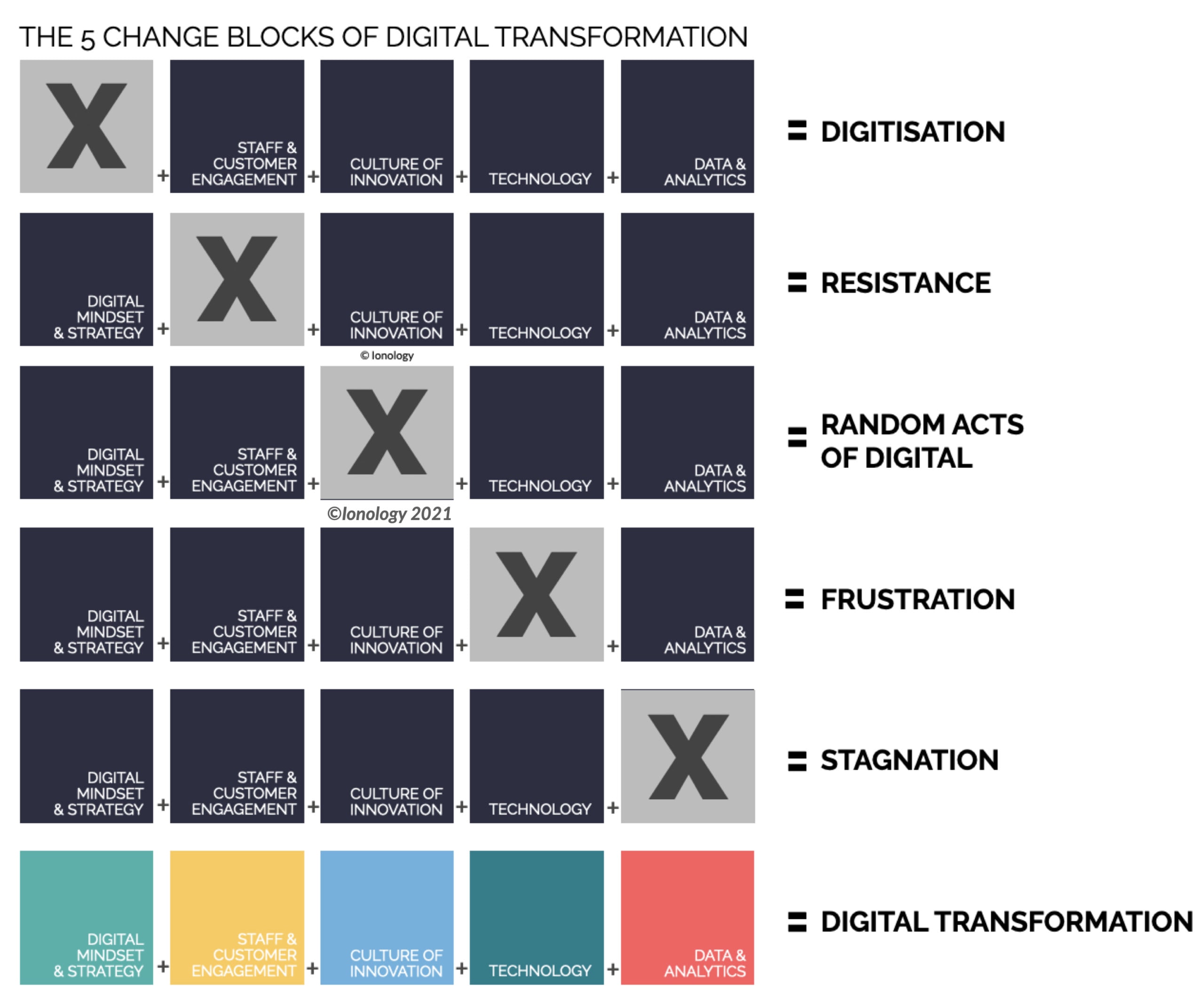
The key to building business confidence in your digital transformation plans is to use data. Data removes subjective road blocks. It moves the conversation away from being one of opinion to being one of fact.
Add greater context to the data by overlaying it with a framework – the consequences and the argument for change grows ever louder.


Finally overlay the ‘as-is’ state of the business or business unit and create an inspirational ‘to-be’ state using supporting data and the chances of getting the business case accepted grows significantly.
Digital Transformation Framework for Strategy
Almost every business gets the term ‘strategy’ confused with operational plans, targets or even power statements. Many businesses have a web strategy, a social media strategy, a content strategy, a technology strategy, a communications strategy, a HR strategy……Almost all of these ‘strategies’ are not strategic. They are operational.
Michael Porter is the Bishop William Lawrence University Professor at Harvard Business School. He’s famed for his ‘Porter’s 5 Forces’ as well as his books on strategy and creating competitive advantage. He argues that operational effectiveness is not strategy. Strategy is not performance targets or acquisitions.
So with this knowledge, what makes a good Digital Transformation Strategy?
Digital transformation strategies use both historic and predictive data to identify new business opportunities. A digital transformation strategy is designed to reposition a business in the digital economy. The repositioning process leverages emerging technology in order to create new products, services and business models that customers favour over the old. Strategies promote rapid exploration, innovation and collaboration. The strategy exposes internal teams to the big ‘unknowns’ that the company would like solved, linking the deliberate innovation directly with the strategic direction of the business. These strategies are created using digital transformation frameworks.
👎
|
👍
|
|---|---|
|
Used to set targets |
Used to define business change |
|
Promote digitisation and operational efficiency only |
Promote transformation, innovation and new business models, products and services |
|
Recycled old-school management consultancy frameworks |
Purpose built digital transformation strategy frameworks |
|
Subjective analysis like SWOT or gut feeling. |
Data-Enriched Decision making using Machine Learning enabled forecasting |
|
Static strategy revised every year |
Dynamic and changeable as experiments and new data comes to light |
|
Built for the boss…to connect with the corporate strategy |
Built to guide those that have to deliver the strategy by defining the unknowns |
|
Unconnected with innovation |
The defined ‘unknowns’ drive the innovation |
Roadmapping Digital Transformation Framework for Strategy
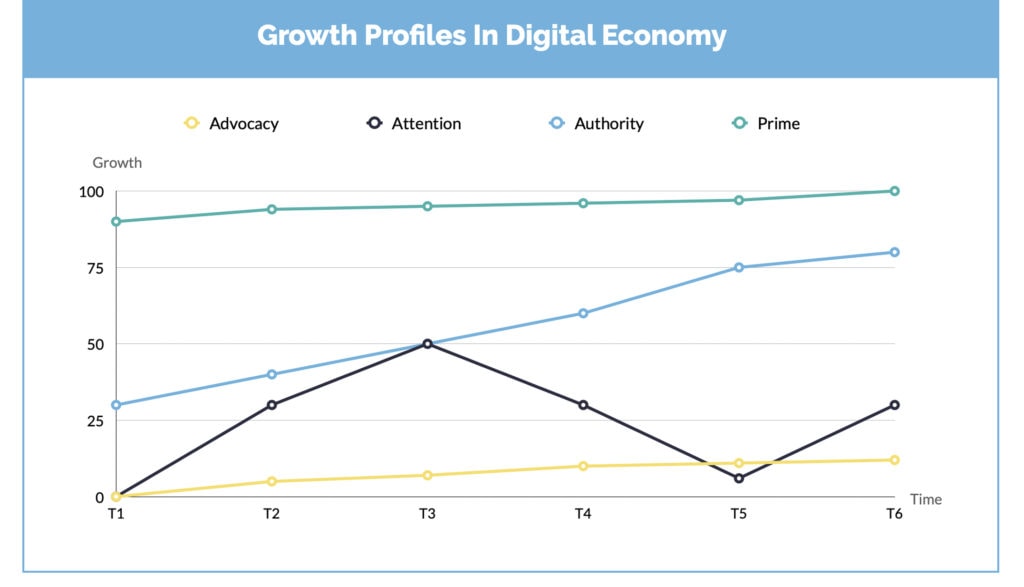
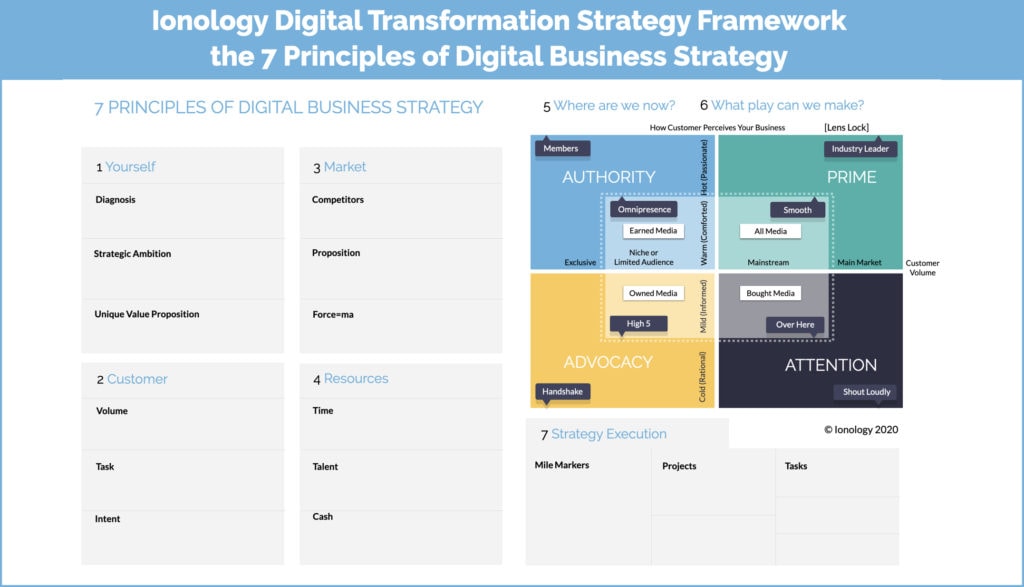
Digital transformation frameworks for strategy assistance are somewhat like having a hydraulic excavation tool. They assist but they don’t build the house. That requires architects plans, artisans and builders. Having the right tools can accelerate the process but human skill is still required. Data gives us insights, but turning those insights into actions requires taught skills.
Prof. Niall McKeown explains, by way of a case study, how digital transformation frameworks can be used to build strategy and success in a small business. The video goes on to explain how those strategies become actionable.
There are not many ‘how-to’ videos on YouTube that are 45 minutes in length that also have thousands of views. This is the rare exception.
Prof. McKeown runs 5-day courses for those that want to learn how to use digital transformation frameworks for customer insights, strategy and delivery. The courses are for reasonably experienced business and technology consultants as well as senior leaders within a business that need to lead digital transformation.
Digital Transformation Frameworks for Creating Vision

The answer to all of these questions is that non-technical leaders see Machine Learning, IoT, Blockchain and other emerging technologies as side projects, rather than seeing them as possible causes of business disruption and their own demise.
Most IT professionals are not given the permission to change the workforce design, the operating model or even products and services. They are instead tasked with operational efficiency.
Operational efficiency is, of course, a worthy pursuit. It’s been a business practice since the industrial revolution. However, operational efficiency is often not transformational.
The solution is to help non-technical leaders, managers and decision makers better understand where they are now “As-Is” and where they can go in the future “To-Be”. To have a more informed ‘digital-powered-vision’.
Explaining the value that transformation creates, the urgent need to get involved and allowing non-technical leaders and technical professionals alike to discuss the business future without getting swamped in technical conversations leads to the creation of a much clearer vision for the business and makes digital transformation a much smoother experience.
From ‘As-Is’ to ‘To-Be’
Match Digital Transformation Strategy with Vision
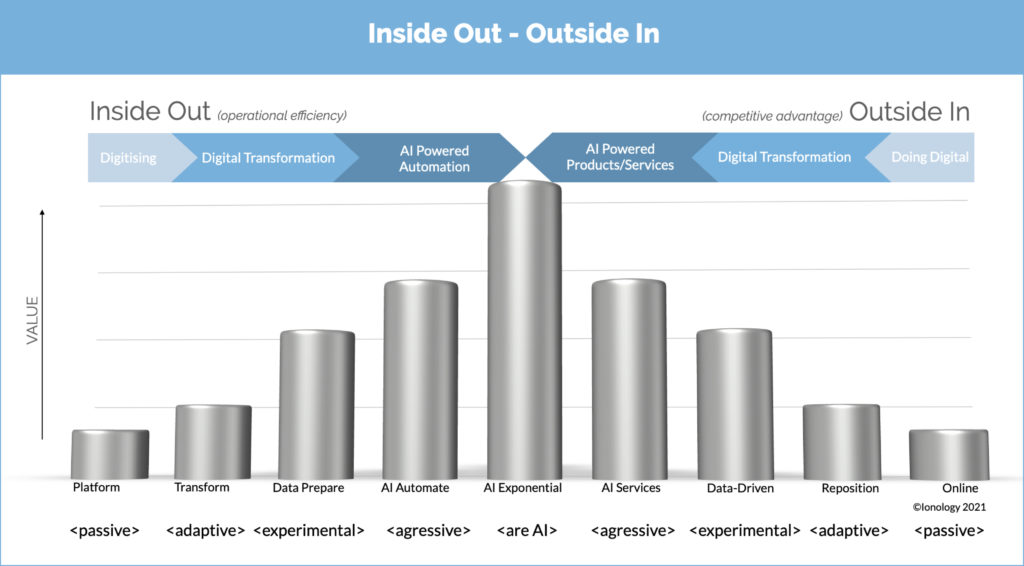
Digital Transformation Frameworks for Operating Models
What is a digital transformation operating model?
A digital transformation operating model is organisational design for the digital age.Building a successful business in the digital economy takes different talents, in different roles, doing different things than in the more traditional operating mode.
The operating model describes how a business will leverage the resources at hand in order to meet the strategic needs.
When it comes to digital transformation, especially in mid-to-larger organisations, the operating model will shift depending on the level of urgency when it comes to digital transformation.
From a leadership or consultancy perspective, strategies often fail to show a return on capital when the operating model isn’t adjusted to match the strategic ambition.
A simple way to consider which operating model is needed for any given business is to compare the level of urgency for transformation against resources. It’s not uncommon that the resources needed don’t match the ambition.
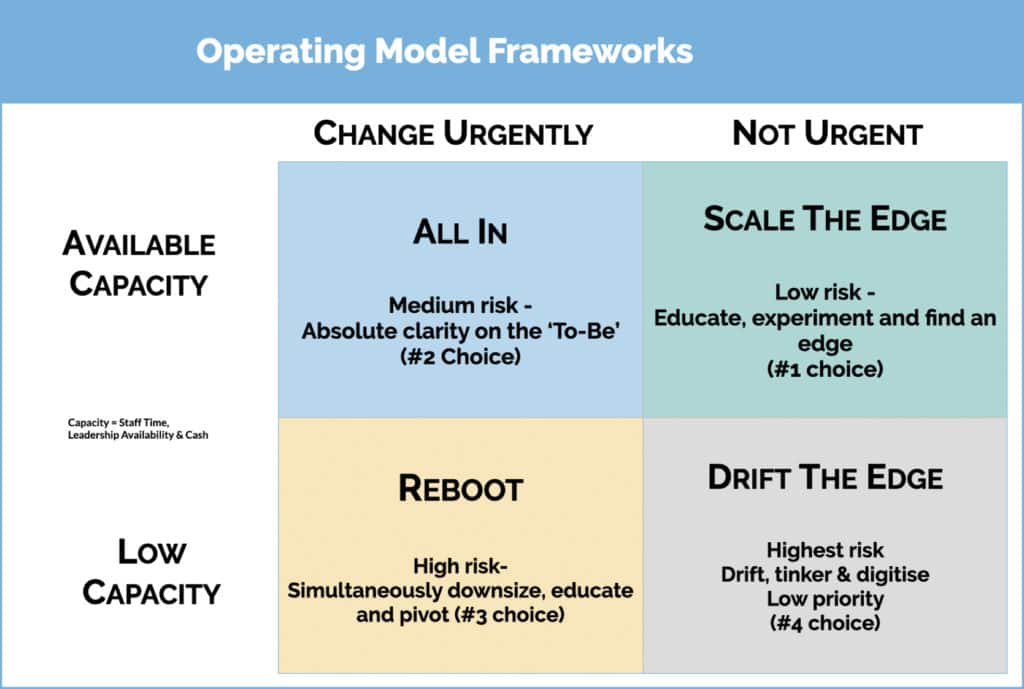
Align Business Resources With Strategic Ambition:
Strategy >> Operating Model >> Design
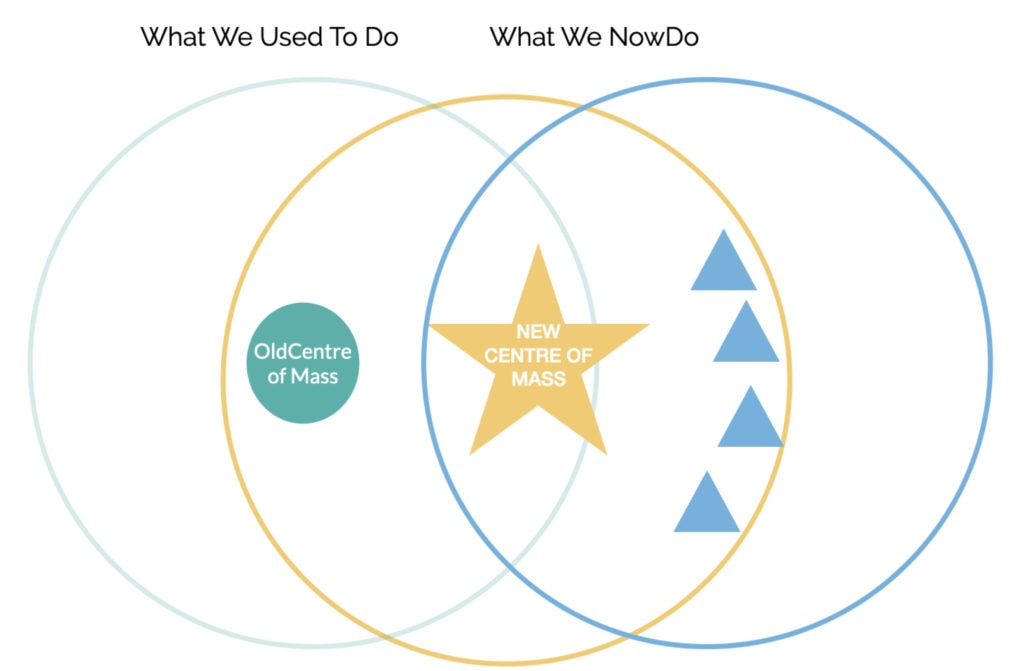
Why Consider a New Operating Model for Digital Transformation?
Businesses that have no immediate disruption on their horizon can choose a different operating model from those that face imminent disruption.
Once the operating model is chosen, only then is it possible to augment the workforce design.
While small businesses often don’t need to go to this level of detail, medium to larger businesses most definitely do. In an attempt to maintain ‘business-as-usual’ and transform at the same time, they underestimate the amount of change required to the workforce in order to achieve their strategic goals.
Too often they assign Digital Transformation to the IT department, give them no authority to change the workforce design or even consider new operating models.
Digital innovators don’t face such problems. They use digital transformation frameworks for operating models to help them make the right selection.
Digital Transformation Frameworks for Digital Innovation
Leaders will not be replaced by AI. However, Leaders that understand AI will replace those that don’t.
If business units are to leverage the power of emerging technology they must first understand its business capabilities. Digital Transformation Frameworks for Emerging Technologies, associated experiments and learning assets help non-technical leaders integrate emerging technology into their strategic plans.
Too often businesses ‘tick the box of emerging tech’ by implementing chatbots or IoT sensors in their own offices and factories. They don’t have the confidence or the know-how on how to integrate emerging technology into the heart of their strategies and value creation process for their customers.
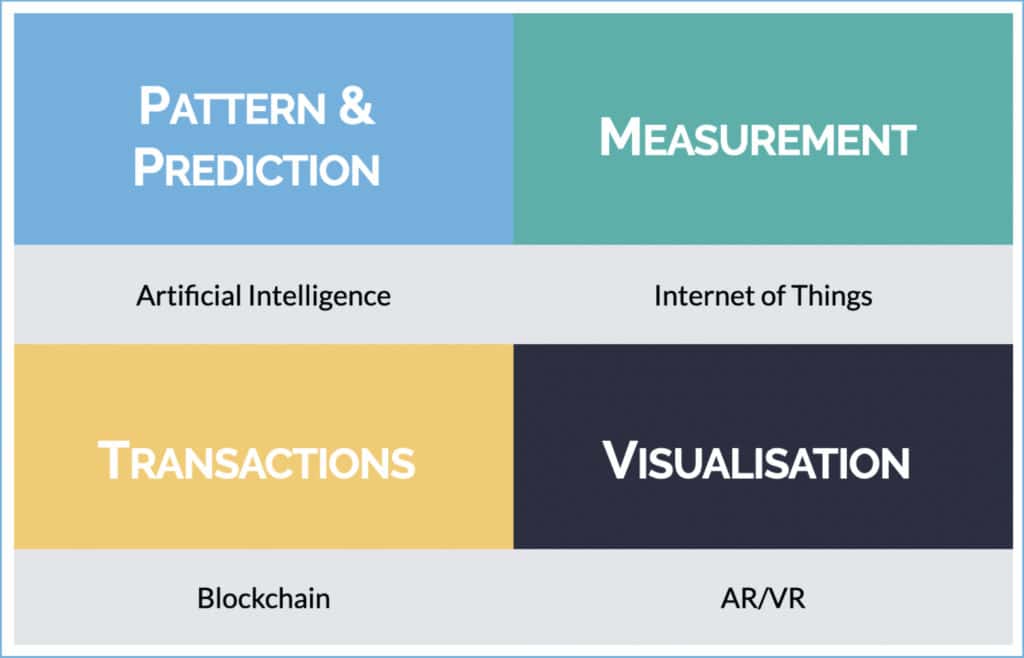
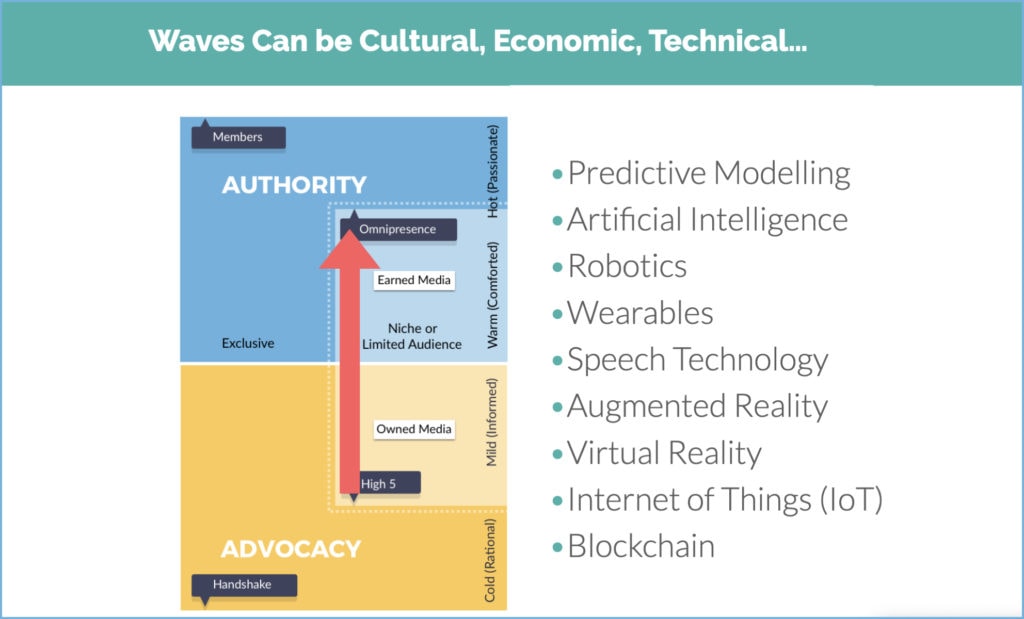
Digital Transformation Frameworks for Emerging Technologies helps bridge the natural gap between technology professionals and business leaders. Technology is an enabler, a tool, it is not strategic in its own right. However, technology can also inspire, guide and help foresee how things will change in the future.
Digital Transformation Frameworks for Emerging Technology such as Machine Learning, Internet of Things, Blockchain and Cloud helps businesses accelerate the implementation of these technologies in order that the business unit can create new, sustained, competitive advantage in the digital economy. Moreover, once business leaders understand the power of this emerging technology it often influences business models and workforce design.
Digital Transformation Frameworks for Emerging Technologies
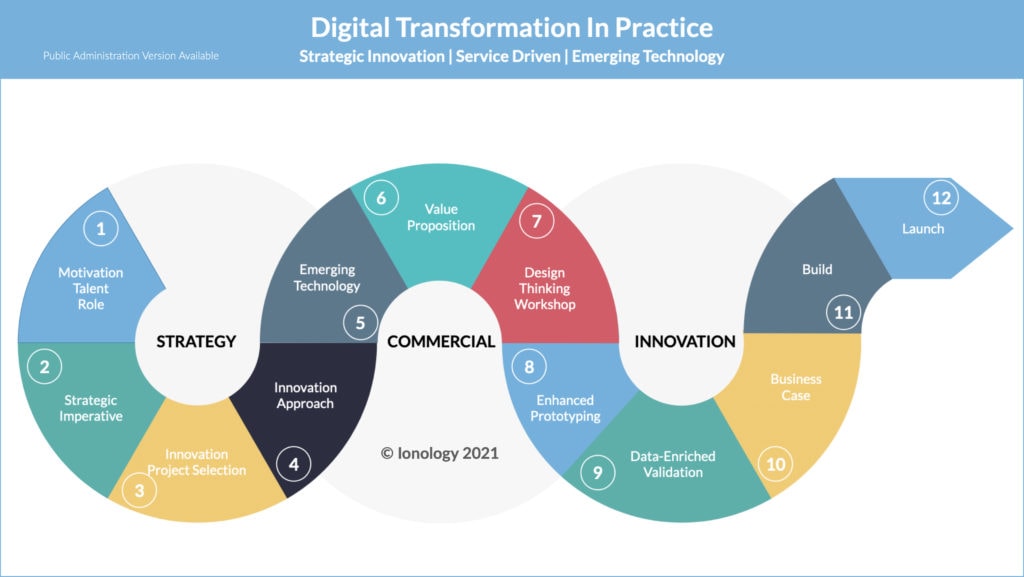
How do I Sustain The Process of Digital Transformation?
Getting digital transformation started is difficult enough but sustaining the momentum is harder.
Fill In the Blanks
We are transforming from _______ into _______ because we are going to to do ________ for ________ better than anyone else.
Most businesses fail to link their strategy with their innovation plans. We believe that digital innovation is the beating heart of any digital transformation strategy. Its purpose is not to come up with some disruptive, blue sky, industry shaking app. Its purpose is to answer the diagnosed ‘unknowns’ that appear in the strategy.
Often the process of Design Thinking is hurled at all problems as if the process itself is going to produce magic. During early stage digitisation it’s the wrong tool for the job. While Design Thinking is a wonderful process, at the right time, it’s only one small part of developing a culture of digital innovation. And we know that digital innovators outpace the growth of those that perform random acts of digital.
If the digital transformation strategy is built using old-school management consultancy frameworks, innovation is usually an after-thought, a bolt on, a separate item on the agenda. This is why most digital transformation efforts fail to show a return on capital invested.
Digital Transformation Frameworks for Digital Innovation help link workforce design, connect via data to the transformation strategy, commercial/service design and customer experience. It results in the visible output the transformation project needs.
If digital transformation is going to be sustained, a flexible set of tools and instructions are needed that go way beyond design thinking.
Sample Digital Transformation Frameworks
© Ionology 2021 – All Rights Reserved.
FAQ
Digital Transformation Frameworks Questions and Answers
Some businesses don’t feel the need to digitally transformation. They may be right! Not every business has to digitally transform and the level of urgency to do so is often exaggerated. However, businesses that are growing fast find that a lack of agility can often end their run of good fortune as industry innovators change customer behaviours.
Take for example the Hotel sector. Few foretold that middle-men like booking.com would be capable of taking 15%+ of their booking revenue back in the early 2000s. Could they have done something about it? Yes, they could have. If they deployed massively simplified booking engines and followed customer data. The data shows that most people seek out the hotels website before booking on the 3rd party middle-men. The hotel website must be the same price as the third party aggregator however the hotel website wants to ‘upsell you’ breakfast, champagne or rose petals. 95% of customer purchase the cheapest room and assume that breakfast and champagne are for sale when they get there. The hotel pays 15% because they didn’t look at the data and experiment.
Using a digital transformation framework and methodology would likely have lead the hotel to this conclusion long before it was too late. Digital transformation frameworks are a great way of exploring the changing customer trends, adding context to data and making innovation choices that are strategically aligned.
Below is a digital transformation tool created by Ionology that lets us very rapidly ask a few questions and let the customer self-select if they need to digitally transform or not.
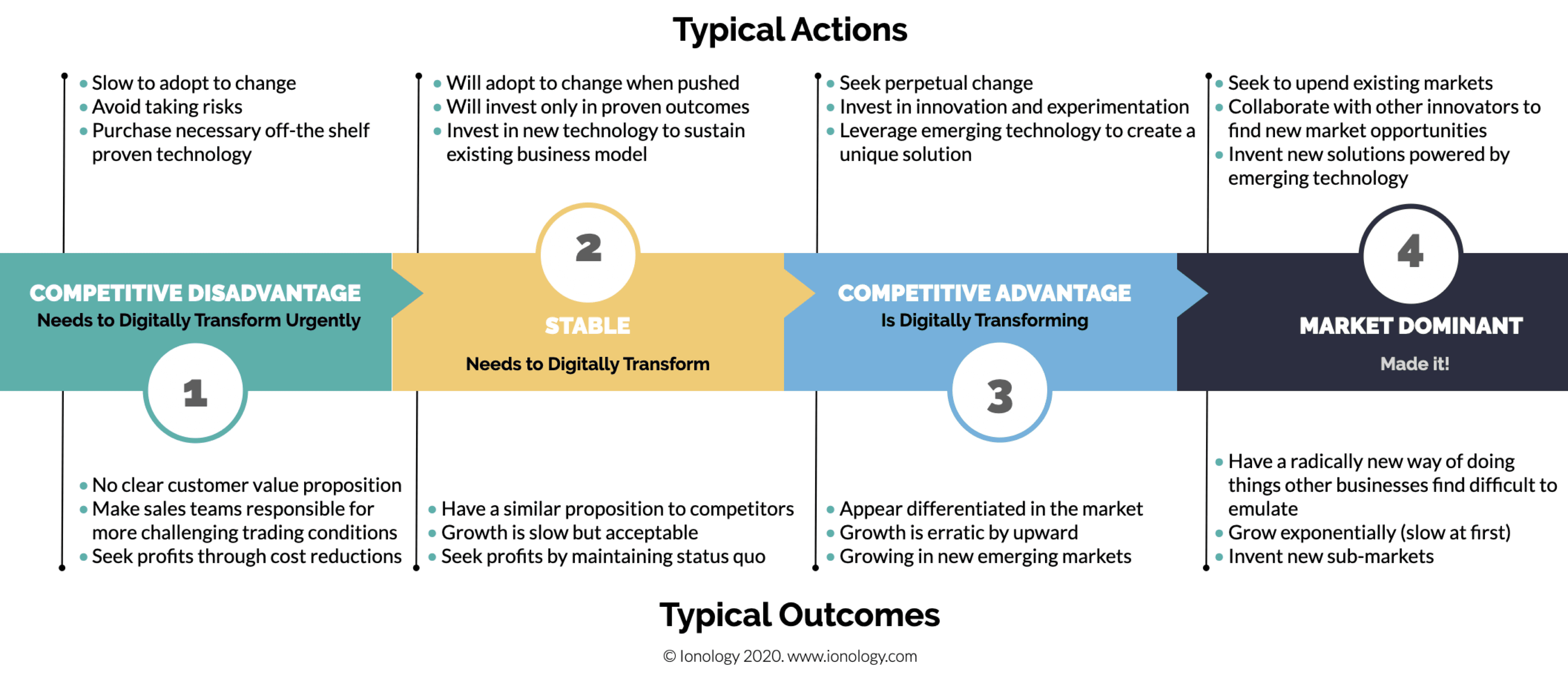
Tool to Rapidly Test if a Commercial Organisation Needs to Digitally Transform
Yes, under licence.
Ionology digital transformation frameworks are copyright. They are not open-source. Our partnership programs offer a variety of assets that any licensed public administration, enterprise or consulting practice can use. The Ionology toolbox of digital transformation assets can then be implemented by you with no additional cost as long as the licence is maintained.
The images shared can not be replicated, modified or incorporated into other digital transformation frameworks without consent.
Special agreements are available to academic institutions that wish to utilise Ionology frameworks in their courses.
As we are sure you can appreciate, the creation of this intellectual property is expensive and has taken many years. We would appeal to your good nature to help us continue our business by licensing the content rather than stealing it.
A business strategy focuses on the operation of the existing business. A digital transformation strategy is a plan of action to reposition a business in the digital economy by changing how it competes, innovates and delivers its products and services.
Many in both private and public sector conflate ‘digitisation’ with ‘transformation’. Digitisation is a required first step in order that basic systems and processes are computerised. This is considered a basic, essential exercise in operational efficiency. It is not, however, transformational. It does not reposition a business in the digital economy by way of new business models, products and services.
- A banking mobile app is not transformational, it’s a customer expectation.
- Getting an invoice online is not transformational. It’s a minimum customer expectation.
- Having application forms online is a customer expectation.
Upgrading these functions may appear in a digital strategy or even a business strategy but they are not considered as ‘transformational’ features in a digital transformation strategy as they represent normal running objectives of the intuition.
The starting point for any digital transformation project is with strategy and with strategy. We have to use the 7 Principles of Digital Transformation Framework, developed by Ionology. It is academically peer-reviewed and taught in many leading universities. Out of the framework; you can start with any of the first 6. #1 Know yourself, #2 Know your customer, #3 Know your market place, #4 Know your resources, #5 Where are you now?, #6 Where do you want to go? #7 is Creating your Strategic POA. Most people feel more comfortable starting with where they are now and where they want to go. But it is equally as valid to start with “Know Yourself”, a diagnosis of the situation and articulate your unique VP going forward. Strategy is not written in a linear sense, as we get more data and we start to query the process, our value proposition can change, our ambitions can change, until we reach the time where we are content with our chosen play or pathway. The advice which we would offer is to start at number one “know yourself” and truly diagnose the current situation as to “why we need change” or start with number 5 which is “where are we now” as both are similar inward reflections of your organisation.
The framework works for any organisation prepared for change. The organisation must first have accepted there is a requirement for transformation and then must be willing to accept data will give guidance but leadership must take decisions. Marketers can communicate, but value propositions must be made. Technologists can deliver technology, but the endgame of what they’re trying to achieve must be clearly articulated and understood before technology is included. It will work for any organisation whether they are commercial or public sector, charitable or even political. The challenge each organisation has is making sure the culture is willing to accept change. However, the framework will accommodate any organisation.
The framework takes an in-depth look at what you would like to achieve in terms of your own ambitions and how you can create a unique value proposition. It uses data to understand what is happening in your marketplace – who are your competitors, how much momentum do they have and how can you create a plan to displace them? It also uses data to establish what the customer demand is and understand if you are able to attract enough customers with your value proposition. The framework takes into consideration the available resources your organisation has in order to be able to calculate if you have enough resources to achieve your stated ambition. It provides a list of “plays” or pathways your organisation can take from where it currently is to where you want it to be, taking into consideration whether you have capacity, capabilities and innovations to drive the change needed within your organisation. Last is the execution of your organisations new strategy using the all important tactics to be carried out in order to deliver upon your ambition. The framework guides you through the process of gathering the data, calculating the requirements and creating measured outcomes. It principally requires inputs from leaders, marketers and technologists to drive the organisation forward on your chosen path of growth.
Leadership skills are typically needed – best suited for leaders and decision makers who can ask the right searching questions when trying to diagnose the situation and can lead organisations through change. These individuals will also have the ability to remove the ‘noise’ from the conversation and understand the strategic imperatives. The challenge with many organisations that have undertaken this in-house, is that they can quickly get swamped, resorting back to tactical, non-strategic actions that run and drive day-to-day business; talking about their internal capabilities and desires as opposed to the strategic way ahead.
It is strongly advised that you attain an external person/resource, free from corporate baggage, who can ask questions and keep the conversations strictly strategic and in line with the framework, to prevent people from drifting into anecdotal hearsay about why they should or shouldn’t be performing particular tasks. The preference is external, but this is not to say it cannot be done by an impartial leader who can make pragmatic decisions.
The data can come from using software provided by Ionology or other third-party sources. For example, if you wish to find out how your competitors are doing online, our free software tool propulsion.ionology.com will enable you to score yourself against them.
If you want to ascertain customer demand in the marketplace, use google keyword planner. Experimentation can be used to make judgement calls on customer tasks and intent to complete particular tasks. For more information on what data can be obtained and how, take our free Digital Transformation training course or get in touch.
There are mechanisms within the cultural block of the transformation Framework that will help you create the right cultural change. Cultural change does not mean you have to stop doing what your organisation does and immediately switch over to what you would like to do.
There are proven methods to address this. These methods need to be resourced to ensure business as usual is delivered whilst enabling the transformation process to begin by a series of small transitions, growing into much larger transitions.
The Framework uses data to calculate both customer demand and competitive force within the marketplace.
It will tell you if you have the right resources before entering new markets, creating new markets or competing in existing markets.
The framework will tell you if you have a clear ambition and a clearly articulated value proposition.
It will tell you what strategic “play” or pathway best suits your organisation’s growth plans and how to execute.
Most of all, by choosing a play, you will be able to understand much more clearly what actions and tactics you should not be partaking in, as well as those which should be encouraged.
Finally, the framework will help you develop a coherent plan of action, a set of tactics and defined outcomes which are typically delivered through technology and communications. It will provide the guidance required for your organisation to improve innovation and close capability gaps.
